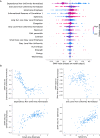Radiomics using computed tomography to predict CD73 expression and prognosis of colorectal cancer liver metastases
- PMID: 37501197
- PMCID: PMC10375693
- DOI: 10.1186/s12967-023-04175-7
Radiomics using computed tomography to predict CD73 expression and prognosis of colorectal cancer liver metastases
Abstract
Background: Finding a noninvasive radiomic surrogate of tumor immune features could help identify patients more likely to respond to novel immune checkpoint inhibitors. Particularly, CD73 is an ectonucleotidase that catalyzes the breakdown of extracellular AMP into immunosuppressive adenosine, which can be blocked by therapeutic antibodies. High CD73 expression in colorectal cancer liver metastasis (CRLM) resected with curative intent is associated with early recurrence and shorter patient survival. The aim of this study was hence to evaluate whether machine learning analysis of preoperative liver CT-scan could estimate high vs low CD73 expression in CRLM and whether such radiomic score would have a prognostic significance.
Methods: We trained an Attentive Interpretable Tabular Learning (TabNet) model to predict, from preoperative CT images, stratified expression levels of CD73 (CD73High vs. CD73Low) assessed by immunofluorescence (IF) on tissue microarrays. Radiomic features were extracted from 160 segmented CRLM of 122 patients with matched IF data, preprocessed and used to train the predictive model. We applied a five-fold cross-validation and validated the performance on a hold-out test set.
Results: TabNet provided areas under the receiver operating characteristic curve of 0.95 (95% CI 0.87 to 1.0) and 0.79 (0.65 to 0.92) on the training and hold-out test sets respectively, and outperformed other machine learning models. The TabNet-derived score, termed rad-CD73, was positively correlated with CD73 histological expression in matched CRLM (Spearman's ρ = 0.6004; P < 0.0001). The median time to recurrence (TTR) and disease-specific survival (DSS) after CRLM resection in rad-CD73High vs rad-CD73Low patients was 13.0 vs 23.6 months (P = 0.0098) and 53.4 vs 126.0 months (P = 0.0222), respectively. The prognostic value of rad-CD73 was independent of the standard clinical risk score, for both TTR (HR = 2.11, 95% CI 1.30 to 3.45, P < 0.005) and DSS (HR = 1.88, 95% CI 1.11 to 3.18, P = 0.020).
Conclusions: Our findings reveal promising results for non-invasive CT-scan-based prediction of CD73 expression in CRLM and warrant further validation as to whether rad-CD73 could assist oncologists as a biomarker of prognosis and response to immunotherapies targeting the adenosine pathway.
Keywords: Adenosine pathway; CD73; Cancer; Immune checkpoint; Interpretable machine learning; Radiomic biomarker.
© 2023. The Author(s).
Conflict of interest statement
Outside the submitted work, ST has received consultant fees from Bristol Myers Squibb and Turnstone Biologics, speaking fees from Celgene and Astra Zeneca, and has research funding from Lovance Biotherapeutics and Turnstone Biologics. JS is a permanent member of the scientific advisory board of Surface Oncology and holds stocks of Surface Oncology.
Figures








References
-
- Kanemitsu Y, Shimizu Y, Mizusawa J, Inaba Y, Hamaguchi T, Shida D, et al. Hepatectomy followed by mFOLFOX6 versus hepatectomy alone for liver-only metastatic colorectal cancer (JCOG0603): a phase II or III randomized controlled trial. J Clin Oncol. 2021;39(34):3789–3799. doi: 10.1200/JCO.21.01032. - DOI - PubMed
Publication types
MeSH terms
Substances
LinkOut - more resources
Full Text Sources
Medical
Research Materials
Miscellaneous

